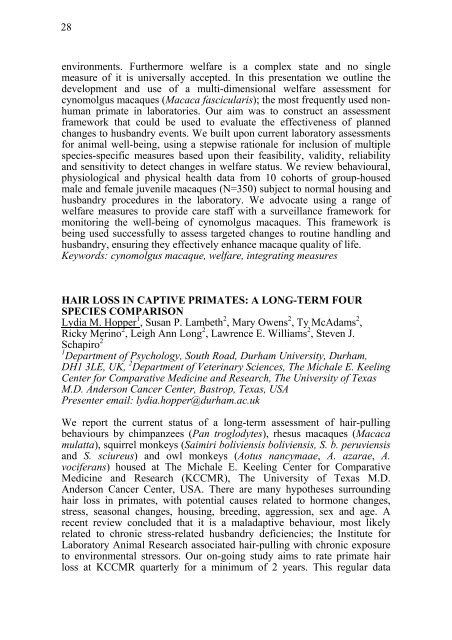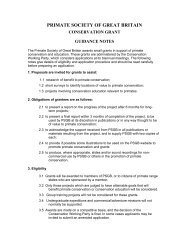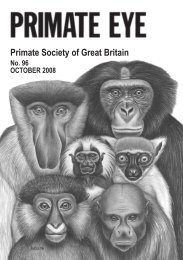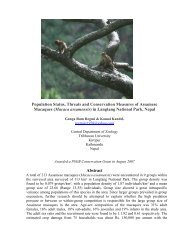2009 Vol 99.pdf (2.45mb) - Primate Society of Great Britain
2009 Vol 99.pdf (2.45mb) - Primate Society of Great Britain
2009 Vol 99.pdf (2.45mb) - Primate Society of Great Britain
Create successful ePaper yourself
Turn your PDF publications into a flip-book with our unique Google optimized e-Paper software.
28<br />
environments. Furthermore welfare is a complex state and no single<br />
measure <strong>of</strong> it is universally accepted. In this presentation we outline the<br />
development and use <strong>of</strong> a multi-dimensional welfare assessment for<br />
cynomolgus macaques (Macaca fascicularis); the most frequently used nonhuman<br />
primate in laboratories. Our aim was to construct an assessment<br />
framework that could be used to evaluate the effectiveness <strong>of</strong> planned<br />
changes to husbandry events. We built upon current laboratory assessments<br />
for animal well-being, using a stepwise rationale for inclusion <strong>of</strong> multiple<br />
species-specific measures based upon their feasibility, validity, reliability<br />
and sensitivity to detect changes in welfare status. We review behavioural,<br />
physiological and physical health data from 10 cohorts <strong>of</strong> group-housed<br />
male and female juvenile macaques (N=350) subject to normal housing and<br />
husbandry procedures in the laboratory. We advocate using a range <strong>of</strong><br />
welfare measures to provide care staff with a surveillance framework for<br />
monitoring the well-being <strong>of</strong> cynomolgus macaques. This framework is<br />
being used successfully to assess targeted changes to routine handling and<br />
husbandry, ensuring they effectively enhance macaque quality <strong>of</strong> life.<br />
Keywords: cynomolgus macaque, welfare, integrating measures<br />
HAIR LOSS IN CAPTIVE PRIMATES: A LONG-TERM FOUR<br />
SPECIES COMPARISON<br />
Lydia M. Hopper 1 , Susan P. Lambeth 2 , Mary Owens 2 , Ty McAdams 2 ,<br />
Ricky Merino 2 , Leigh Ann Long 2 , Lawrence E. Williams 2 , Steven J.<br />
Schapiro 2<br />
1 Department <strong>of</strong> Psychology, South Road, Durham University, Durham,<br />
DH1 3LE, UK, 2 Department <strong>of</strong> Veterinary Sciences, The Michale E. Keeling<br />
Center for Comparative Medicine and Research, The University <strong>of</strong> Texas<br />
M.D. Anderson Cancer Center, Bastrop, Texas, USA<br />
Presenter email: lydia.hopper@durham.ac.uk<br />
We report the current status <strong>of</strong> a long-term assessment <strong>of</strong> hair-pulling<br />
behaviours by chimpanzees (Pan troglodytes), rhesus macaques (Macaca<br />
mulatta), squirrel monkeys (Saimiri boliviensis boliviensis, S. b. peruviensis<br />
and S. sciureus) and owl monkeys (Aotus nancymaae, A. azarae, A.<br />
vociferans) housed at The Michale E. Keeling Center for Comparative<br />
Medicine and Research (KCCMR), The University <strong>of</strong> Texas M.D.<br />
Anderson Cancer Center, USA. There are many hypotheses surrounding<br />
hair loss in primates, with potential causes related to hormone changes,<br />
stress, seasonal changes, housing, breeding, aggression, sex and age. A<br />
recent review concluded that it is a maladaptive behaviour, most likely<br />
related to chronic stress-related husbandry deficiencies; the Institute for<br />
Laboratory Animal Research associated hair-pulling with chronic exposure<br />
to environmental stressors. Our on-going study aims to rate primate hair<br />
loss at KCCMR quarterly for a minimum <strong>of</strong> 2 years. This regular data






